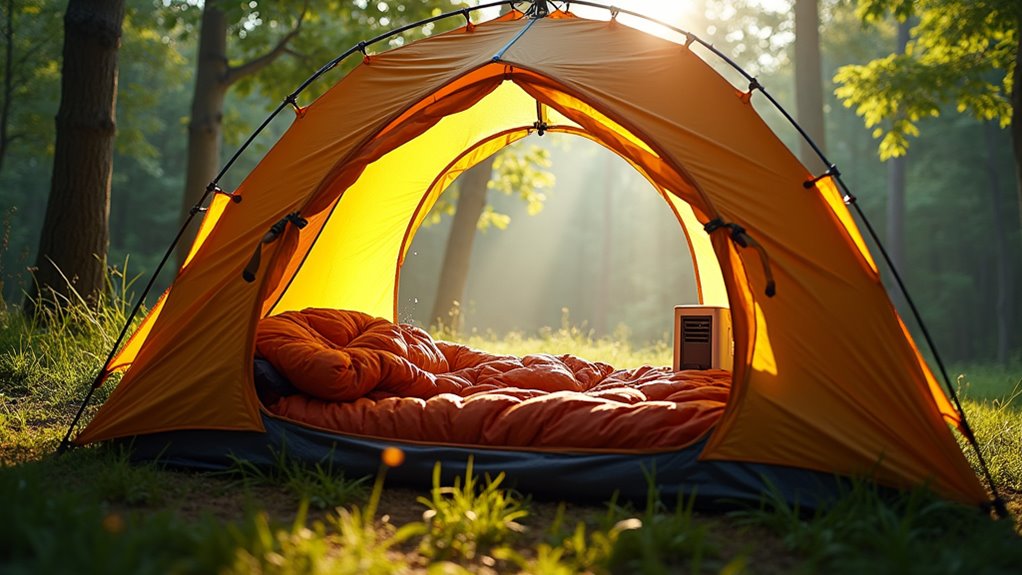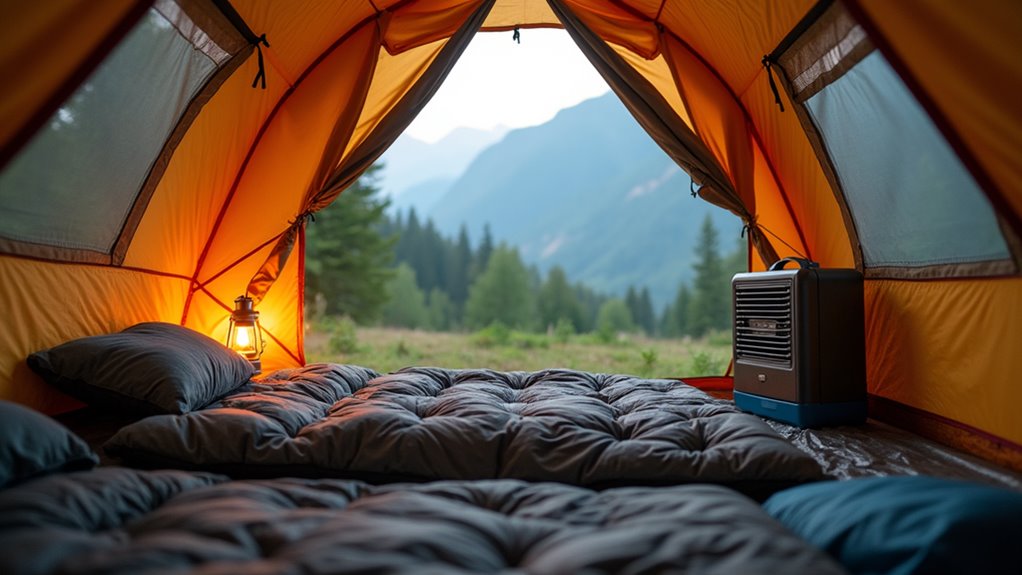How Do You Stop Condensation In A Tent
This post contains affiliate links. As an Amazon Associate, we earn from qualifying purchases.
To stop condensation in your tent, focus on improving ventilation and managing moisture effectively. This includes choosing a flat, elevated campsite away from water sources, using both doors for cross ventilation, and keeping vents open. Additionally, remove wet clothes and dry gear outside before entering, and pitch your tent tightly while ensuring it is set up high enough to reduce humidity buildup. Further explanation and detailed tips will be provided later in the article to help you enhance your camping experience.
Essential Facts in 30 Seconds
- Choose a dry, elevated site to avoid water and reduce humidity.
- Ventilate the tent by opening doors and windows for airflow.
- Remove wet gear and clothes before entering to limit moisture inside.
- Use insulated materials under your sleeping area to prevent dampness.
- Keep the tent zipped when not in use to control internal moisture.
Choosing the Right Campsite
Pick a campsite with a flat, level spot to set your tent. This helps keep water from pooling and makes sleeping more comfortable. Choosing a site with good ground conditions can further enhance your tent’s performance during wet weather.
Find a place a bit higher than nearby streams or lakes. This prevents flooding and keeps the ground drier. Avoid low areas where water gathers fast.
Stay away from rocky or hard soil that makes tent setup tough. Dry meadows work better than shady spots, which hold dampness.
Keep a safe distance from water to reduce bugs and pollution risks. Check for dead trees or loose branches above. These can fall and cause injury.
Thinking about these points helps you stay safe and dry. Your tent will feel less damp inside, making your trip better. Additionally, consider pitching your tent in shaded areas to help maintain a cooler and drier environment inside the tent.
Effective Ventilation Techniques
Effective ventilation stops condensation inside your tent, especially in wet weather. Good airflow lowers moisture and keeps your tent dry. Try these simple tips:
- Open vestibule doors fully or partly to let fresh air in and moist air out.
- Use both tent doors to create cross ventilation. This speeds up air exchange.
- Keep inner tent windows open along with rainfly vents. This helps humidity escape. Proper tent setup location can also contribute to reducing moisture levels inside.
Check that all rainfly vents are clear and open wide. Face your tent openings toward the wind for natural airflow. Pitch your tent so the wind blows inside, pushing stale air out.
Keep tent openings open during the night to release trapped moisture. Ensuring your tent has a good ventilation system is crucial for long-term camping comfort.
These steps make camping more comfortable and keep your tent dry. Less dampness means fewer bugs and no wet gear. Good airflow really works to stop condensation.
Managing Indoor Moisture Sources
Indoor moisture can make camping uncomfortable. Control it well to stay dry and cozy.
Breathing releases water vapor. Breathe slowly to lower moisture. Additionally, keeping the tent zipped tight at all times when not in use can significantly reduce moisture buildup.
Sweat wets clothes fast. Take off wet clothes right away.
Wet gear brings dampness inside. Dry gear outside before entering the tent.
Moist ground causes damp floors. Place insulated cloths under your sleeping area.
These simple steps keep your tent dry and pleasant. Stay warm, stay dry! Additionally, consider investing in a high-quality sleeping pad to help manage moisture and enhance comfort during your camping experience.
Tent Pitching Strategies
Pitching your tent well makes camping better. Good setup improves airflow and cuts down moisture inside. Keep tent poles about 125 cm tall. This height helps air move near the tent floor.
Follow these tips for a better pitch:
- Pick a dry, high spot. Water nearby raises humidity and cold air can gather in low areas. Choosing elevated ground is crucial to prevent water accumulation and reduce humidity levels.
- Point tent doors and vents toward the wind. This helps fresh air flow inside.
- Pull tent fabric tight. Tight fabric stops water from collecting in folds and keeps vents open.
These steps help keep your tent dry and fresh. You’ll breathe easier and sleep better. Additionally, using a tent with better insulation properties can further reduce condensation by maintaining a warmer interior temperature.
Weather and Environmental Considerations

Humidity and temperature control condensation inside your tent. High humidity and cold nights cause dampness easily. Wind and fresh air help reduce moisture. Open vents or windows to keep air moving. This stops water drops from forming on walls. Additionally, managing ventilation is crucial to prevent excess moisture buildup inside the tent. To ensure a dry environment, it is important to check for hazards that may lead to increased humidity levels. Dry tents make camping more pleasant and healthy.
Humidity and Temperature Effects
Humidity and temperature play a big role in tent comfort. Cold outside air makes the tent’s inside air hold more moisture. This moisture turns into water drops on cold tent walls. Warm air cools down and meets the dew point, causing condensation.
People breathing, cooking, and sleeping add more moisture. This makes humidity control very important.
Keep your tent dry by adding insulation and using fabrics that pull moisture away. Open vents or windows to let moist air escape.
Check vapor pressure differences to know when condensation might form. Understanding these facts helps you stay dry and enjoy camping more.
Wind and Airflow Impact
Wind and airflow play a big role in stopping tent condensation. Point your tent door toward the wind. This helps air flow inside and outside the tent.
Open vents and windows to let air move freely. Keep gear away from vents to avoid blocking air. Avoid setting up your tent where the air stands still. Pick high spots to stop water from collecting.
Line up vents with the breeze for fresh air all night. Change your tent’s position if the wind shifts. Good airflow cuts down on wet walls and makes your stay dry and comfy.
Seasonal Condensation Patterns
Tent condensation depends on more than just airflow. Seasonal weather and environment play big roles. Knowing these changes helps you keep condensation under control.
Think about these points:
- Temperature drops at night cool surfaces below the dew point. This causes water to form.
- Humidity climbs after rain, making the air around your tent wet. This raises condensation chances.
- Camping near water or low spots makes dampness worse. Pick high, dry ground for your tent.
Understanding Physical and Behavioral Factors

Camping brings many physical and behavioral factors that affect tent condensation. Set your tent on dry, high ground to avoid water pooling. Stay away from lakes or rivers to lower humidity around your camp.
Place your tent under trees to keep it warmer and help air flow. Open tent doors and windows a little to let humid air out. Never dry wet clothes inside your tent; this adds moisture to the air.
Check your tent’s ventilation often at night and adjust it as temperatures change. These steps help keep your tent dry and comfortable.
Frequently Asked Questions
Can I Use a Dehumidifier Inside My Tent?
Using a dehumidifier inside your tent works well to control moisture. It stops damp air from making your gear wet and moldy. Dry air keeps you comfortable and prevents sickness. Keep some fresh air flowing to help the dehumidifier do its job. Avoid bringing wet clothes or water inside to reduce humidity. This simple step improves your camping experience a lot.
How Can I Dry My Tent After Condensation Occurs?
Condensation inside your tent means moisture is trapped. Open all windows and vents to let fresh air in. Shake the tent gently to remove water drops. Take out the rainfly and hang it separately to dry faster. Wipe the tent walls with a clean cloth to soak up dampness. Sunlight and wind help dry the tent quickly. Drying your tent well stops mold and keeps it fresh for next use.
Does the Type of Tent Fabric Affect Condensation Levels?
Tent fabric type plays a big role in condensation levels. Breathable fabrics let air pass through, which helps moisture escape. This reduces water drops inside the tent. Less breathable fabrics block airflow. Moisture gets trapped and causes more condensation. Camping with breathable tents means a drier, more comfortable space. Studies show breathable materials can cut condensation by up to 50%. Picking the right fabric keeps campers dry and happy.
Are There Specific Brands or Models Known for Reducing Condensation?
MSR and The North Face make tents that cut down on condensation well. These tents have good vents and let air flow inside. Some models focus on stopping moisture and keeping air dry. This helps campers stay comfortable and dry all night. Pick tents that say they control humidity or have mesh panels. These features fight fog and water drops inside your tent. Many campers trust these brands for less dampness and better sleep outdoors.
Can Sleeping With a Friend Increase Condensation in the Tent?
Sleeping with a friend in a tent raises humidity inside. Two bodies produce more heat and moisture than one. This extra warmth and breath moisture cause more condensation on tent walls. Studies show shared tents often have 30% higher humidity levels. Condensation can make the tent feel damp and cold. Ventilation helps reduce moisture buildup. Open vents or doors to let fresh air in. Keep sleeping bags away from tent walls to avoid wetness. Sharing a tent means more care to stay dry and comfortable.
Conclusion
Condensation in tents is a common problem. Studies say about 75% of campers face it. Ventilation helps a lot. Open windows or vents to let air flow. Dampness makes condensation worse. Use moisture-absorbing materials inside your tent. Pick a dry, well-drained spot to set up. Avoid low areas where water collects. Use a rainfly with vents to reduce moisture. These steps keep your tent dry and comfy. You will sleep better and enjoy camping more.
